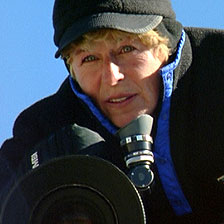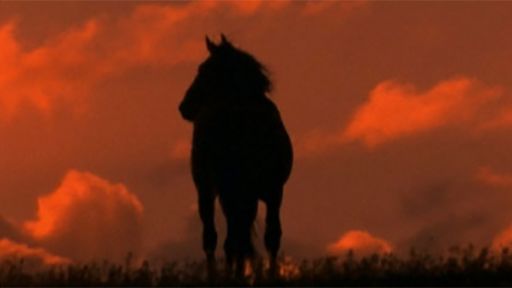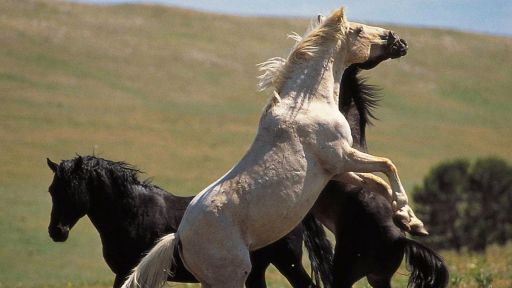 Producer and cinematographer of Cloud: Wild Stallion of the Rockies, Ginger Kathrens is an Emmy award-winning producer/director with experience in feature films and TV documentaries, commercials and national public service announcements, political campaigns, sports programs, and educational films. Her documentary filmmaking trips have taken her to Africa, Asia, Europe, Central and South America, and all over the U.S. She is the President of Taurus Productions, Inc., a company with a 25-year commitment to quality production. Ginger Kathrens is also the author of the book Cloud: Wild Stallion of the Rockies.
Producer and cinematographer of Cloud: Wild Stallion of the Rockies, Ginger Kathrens is an Emmy award-winning producer/director with experience in feature films and TV documentaries, commercials and national public service announcements, political campaigns, sports programs, and educational films. Her documentary filmmaking trips have taken her to Africa, Asia, Europe, Central and South America, and all over the U.S. She is the President of Taurus Productions, Inc., a company with a 25-year commitment to quality production. Ginger Kathrens is also the author of the book Cloud: Wild Stallion of the Rockies.
NATURE Online spoke to Ms. Kathrens in October 2001 about the making of the program:
How did the Cloud project come about?
In 1993, Marty Stouffer, the producer and host of PBS’ WILD AMERICA, asked me to work on a show about wild horses. I said that was great, but then when I hung up the phone, I realized that I knew nothing about wild horses. I’ve ridden horses all my life and I had horses as a kid, but I really and truly did not know anything about wild ones. So I set out to find out about them.
One of my location scouting trips, in 1994, was to an area in southern Montana, an area the Crow Indians call the Arrowhead Mountains. My sister and I happened on this location and early one morning we went out and we saw a black stallion in a band and a three-day-old foal that we named Diamond because he had a big diamond star on his head. That black stallion trotted over to within twenty feet of my sister, blew explosively out his nose, and then they all just raced away. And this first experience of meeting this horse, Raven, who is Cloud’s father, was kind of a magic moment. So the area had a strong spiritual significance to me besides being an absolutely beautiful place.
We started filming there in June of 1994 and I was telling the story of Raven’s family. Actually, we never set out to do a story that was personal in nature. All the wild horse shows that have been produced up until now have been more or less generic in nature. And that was more or less what I intended to do with this show, with a specific focus on the American West. But as it turned out, when I went in June 1994 to start filming in the Arrowhead Mountains, I was driving up the mountain and out of the blue came Raven. And then before I knew it, another stallion raced in and started fighting with Raven and I got a little bit of that on film. It didn’t strike me then but it does now, that I didn’t find these horses; they found me. And this kept happening to me continuously through that summer.
There was a Bureau of Land Management [BLM] (http://www.blm.gov/nhp/index.htm) round-up that fall, and two of the three foals in Raven’s band were killed during this round-up. This was kind of a shocking thing that happened. This was a year before Cloud was born, so this was the setup to the next spring, in which we wanted to see what had happened to Raven and his band. In fact, they had had two fillies. And then in May, I was filming other projects, and then out trots this Palomino mare, Cloud’s mother, with a newborn foal. I didn’t find her; she came and brought the foal right in front of the camera. And that was my introduction to the colt I named Cloud.
And through the years, people hired me to do various projects in this same area. And this brought me repeatedly into contact with the wild horses of the Arrowheads and specifically Cloud. And so just by chance, luck, or fate I had this catalog of a wild horse from 1995 through 1998. Then in 1999, I presented the idea to Fred Kaufman at NATURE. It’s very unusual to have an experience in which you follow a wild animal through its life.
Given that this Arrowhead Mountain area seems immense, it seems mind-boggling that you were able to pick up the trail of this particular band of horses every time you went out to film.
Following the trail has been hard. Especially if you consider that as a two-year-old, Cloud was released after the BLM round-up and disappeared. Every winter thereafter I never was able to find him. So from about November through May, I had no idea where he was; over half of his life was a mystery to me, up until the 2000-2001 winter when I saw him for the first time during the cold season. The horses in the Arrowheads live in a very harsh winter climate. It’s extremely cold, and usually they come down the mountain below the snow line, but Cloud never did do that.
As a bachelor, Cloud went way out in Lost Water Canyon and became totally cryptic; trying to find a white horse in the snow is, you can imagine, virtually impossible. So it took us years to realize that he never did what the other horses did; he didn’t come down the mountain below the snow line. On the contrary, he stayed in the high country, but in an area that’s surrounded on three sides by steep canyon walls, which has heavy tree cover. Really, this was a very dangerous choice by Cloud because if the snow becomes ice-covered, as it did in 1997, almost all of the older horses will die when stranded in such an environment. Nevertheless, he chose to do that with his other bachelor buddies and therefore he was totally impossible for us to find.
My natural instinct when I met Raven and started to follow his family story was to make myself hidden. I realized that wouldn’t work when I hid among some rocks above a water hole, and a band stallion was drinking and he looked up — I’m sure he smelled me — and he did that explosive snort, and then it seemed as if every horse in the country ran because they didn’t know who I was and probably assumed I was a predatory mountain lion hiding in the rocks.
So what I learned was to make myself not cryptic but very obvious and very benign. I would wave to the horses, as if to say, “Here I am,” and then sit down. I would also watch to see in which direction the bands were naturally moving and try to slowly work myself into the path so that if they were moving they would be coming toward me rather than away. And this worked for me in being able to be largely unobtrusive.
One sequence from the show that stands out is Raven protecting his mares from bachelor stallions’ advances. Can you describe this kind of ritual?
There are two kinds of rituals we’re talking about. The band stallion’s role in a family is to be the defender and protector of the mares and of the foals. If the foals wander off, it’s the stallion’s job to retrieve them. So the stallion is usually a very good caretaker of the little ones. If the mares were allowed to do this job, they would likely be subject to being stolen by other stallions. Young stallions live in rowdy groups and slightly older stallions that are five to eight years old will really be a terrific threat for theft of mares, so that’s why the band stallion is charged with the responsibility of keeping everyone together. Raven is a particularly powerful horse, very active, flashy, and charismatic; he won’t hesitate to confront anyone out in the field of battle, so to speak. But he also likes to play around with these younger stallions, so he’ll go out and meet them, touch noses, then scream in an unforgettably haunting call. Then they will defecate and smell their own pile and pivot, kick, and rear up. It’s very ritualistic; the horses are establishing their presence.
Sometimes, it can be a more serious confrontation when the bachelor stallion is older, and that’s what you see in the film. The dun stallion that encounters Raven was probably six or seven years old, and that’s when you have more vocalization and more fighting.
As far as courtship rituals go, most of the stallions are extremely gentle, will talk to the mares, starting from their ears down their neck. And the mares will either turn around and kick them if they’re not interested or they’ll turn around and breed.
In the program, when Cloud is a colt and learning to walk, was his mother very protective? Was it difficult to film this sequence because of that?
Usually, when mares have young foals they are more elusive. Because they are a prey species and not a predatory species, they tend to run and stay away from danger rather than aggressively meeting it. Regarding this sequence, because I had been documenting Raven’s band from the year before, I think I was already viewed as a part of the scenery. I could just as well have been a juniper or a pine. So when Cloud was little, the Palomino mare did elude other people but for one reason or another let me in.
How unusual is Cloud’s white coloration?
He’s a pale Palomino and in some places that is not as unusual as it is in the Arrowheads. But the Arrowheads sport mainly a lot of duns, bays, and blacks, which are primitively marked, well-camouflaged horses. It is very unusual to see a white-colored horse. If you think about it from a survival standpoint, it makes much more sense to be a dun, bay, or black, rather than stand-out white.
How big are these wild horses?
Typically, they are around 70 pounds at birth. They are smaller than domesticated horses, probably 14-15 hands tall versus anywhere from 15-18 hands tall for most domestic horses. Size is very important in survival; you don’t want to have a great big engine to drive if you have limited food resources. So they really have evolved to become this compact, smallish, very tough and durable animal. And that’s why people who have adopted wild horses have found them to be extraordinary in their ability to do endurance and trail riding. The have good sturdy bones and great feet.
Are newborns seasonal?
Yes, the main foaling season is mid-May through mid-June. Cloud was born on May 29th. In 2001, the foals were born very late, all the way from the end of June through the beginning of August. That’s very unusual. In contrast, Raven’s two mares were born in March, which is pretty early.
You adopted the blue roan called Trace. What inspired you to become a wild horse owner?
When I had first seen him in the wild, I thought he was the best yearling. I never thought of adopting any of them. But in 1997 the BLM came out with a list of horses they wanted to remove, and he was on that list. He was the high-priced colt in that auction.
How do you train a wild horse?
Well, he’s still wild. At first, I couldn’t touch him and it was a very slow process of winning the horse’s trust. The only other experiences with humans Trace had prior to this was when he was chased by a helicopter from the wild, removed from his mother when he was still nursing, run through a corral and chute, had blood drawn, freeze-branded on his neck, and taken 600 miles away to Colorado. So you certainly can’t tame a wild horse in 48 hours. Food is a very nice motivator.
One of the most striking sequences in the show is when the stallion Looking Glass kills the young filly foal. How do you explain Looking Glass’s behavior?
That’s definitely the most asked question I get about the program. There are a lot of interpretations of what he did. The foal was not going to be a survivor and Looking Glass may have simply sensed that it was ill and killed it. Another explanation is that the foal did not get up and get out of the way when the elders arrived, and this is a strict rule of horse society. This foal, being ill, couldn’t get out of the way and was punished severely for it. Lastly, it could be that Looking Glass is simply an aggressive animal. He had the opportunity to kill something and he took advantage of it. One of my location scouts saw him breeding one of his mares, and he had her down on the ground by the neck, which is very aggressive and unusual. The bottom line is that the sick foal died quickly, which is a better fate that what could have been in store for him.
It’s obvious you care deeply about these horses and your emotional attachment to them is very plain.
I feel very privileged that these horses have allowed me to eavesdrop on their lives. It’s been a wonderful gift. It’s difficult to know wild animals because at any time you understand that the next time you go up looking for them they might not be there. So that makes it very emotional. I was asked at the Jackson Hole Wildlife Film Festival if I have a back-up plan if something happens to Cloud, and I kind of stared at this gentleman in the audience and said, “No, I have confidence that Cloud will be there.” You know, Cloud doesn’t care a bit that he’s the star of a television program and a book, but my hope for Cloud is that he becomes an ambassador for his species, so that people will realize what great animals they are and therefore want to play a bigger role in preserving them in the American West.
You’re currently working on a sequel to this program. Can you give us a preview of what we will see?
We’re going to see some pretty exciting stuff and things that I would not have predicted. We’re going to see Cloud’s foals that are born, and what happens to them is fairly unpredictable. What’s up for grabs is whether any of these foals from Cloud will survive, and the big question mark for summer 2002 is whether the mare with Cloud produces a foal. We’re also going to learn of the deaths of several horses we have come to know, but this kind of thing happens in the wild. And finally, we will see charming new faces. For those who might be worried, the bottom line is that Raven, Cloud, and Diamond are fine.









